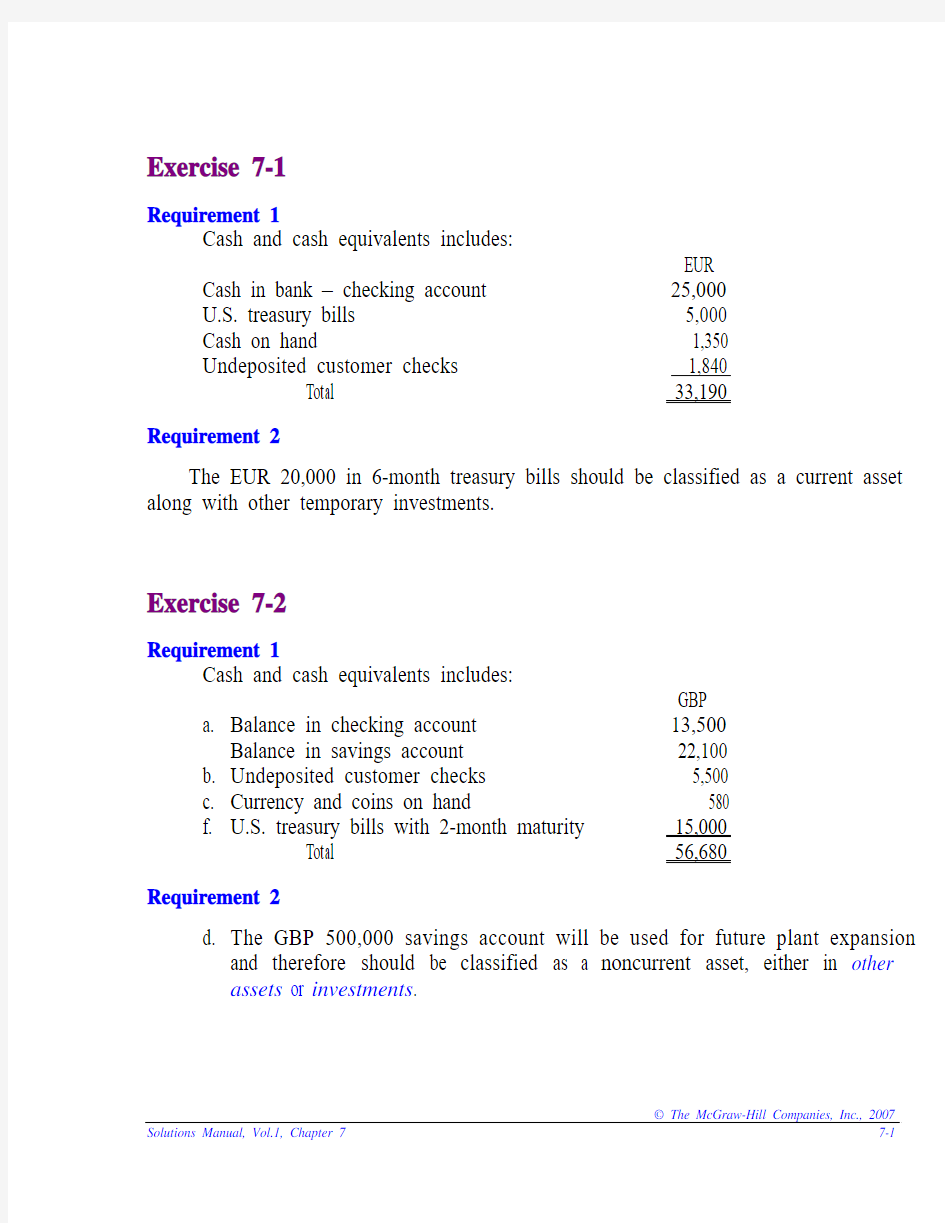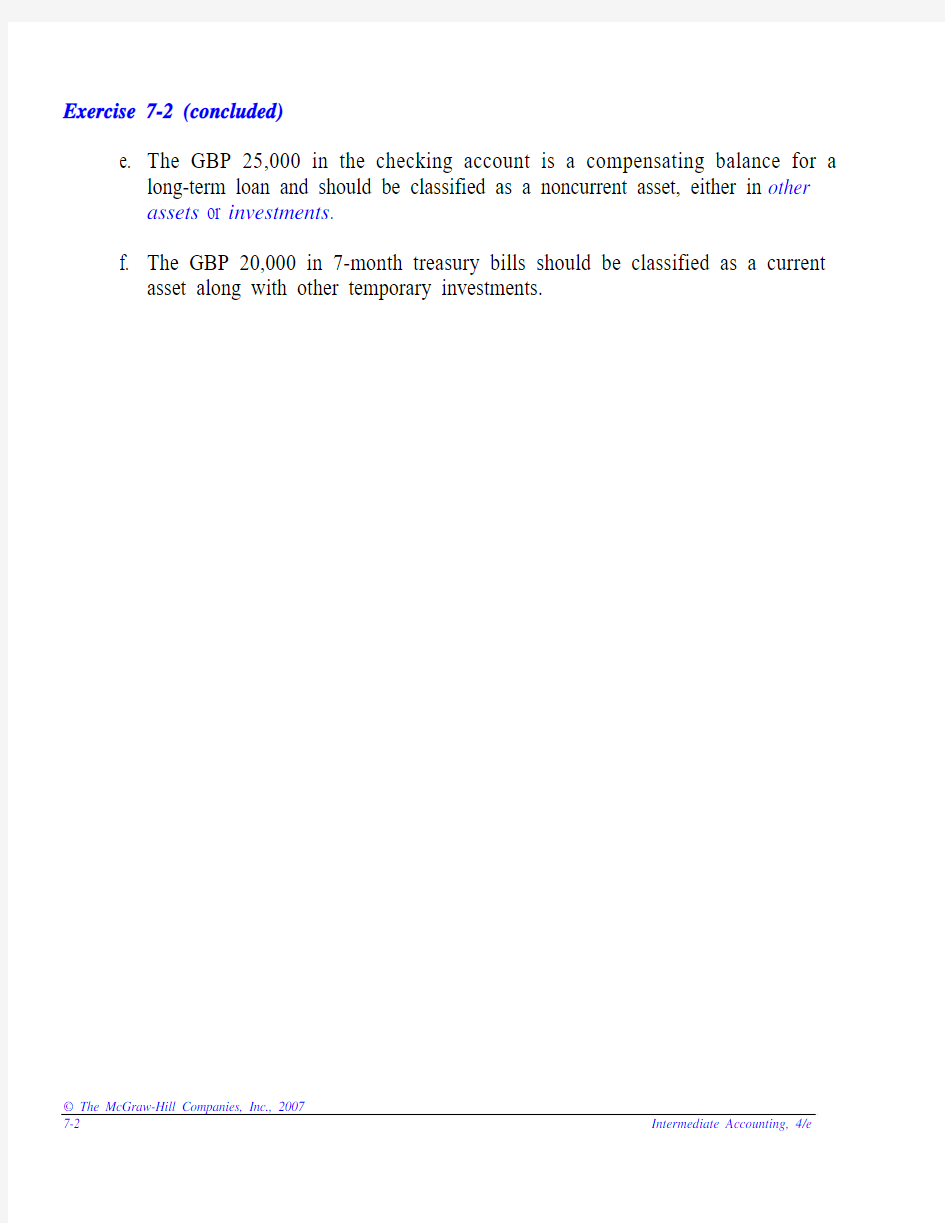Intermediate Accounting------Chapter 7


Exercise 7-1
Requirement 1
Cash and cash equivalents includes:
EUR
Cash in bank – checking account 25,000
U.S. treasury bills 5,000
Cash on hand 1,350
Undeposited customer checks 1,840
Total 33,190
Requirement 2
The EUR 20,000 in 6-month treasury bills should be classified as a current asset along with other temporary investments.
Exercise 7-2
Requirement 1
Cash and cash equivalents includes:
GBP
a. Balance in checking account 13,500
Balance in savings account 22,100
b. Undeposited customer checks 5,500
c. Currency and coins on hand 580
f. U.S. treasury bills with 2-month maturity 15,000
Total 56,680
Requirement 2
d. The GBP 500,000 savings account will be used for future plant expansion
and therefore should be classified as a noncurrent asset, either in other
assets or investments.
? The McGraw-Hill Companies, Inc., 2007 Solutions Manual, Vol.1, Chapter 7 7-1
Exercise 7-2 (concluded)
e. The GBP 25,000 in the checking account is a compensating balance for a
long-term loan and should be classified as a noncurrent asset, either in other
assets or investments.
f. The GBP 20,000 in 7-month treasury bills should be classified as a current
asset along with other temporary investments.
? The McGraw-Hill Companies, Inc., 2007
7-2 Intermediate Accounting, 4/e
Exercise 7-3
Requirement 1
Sales price = 1,000 units x 55 = 55,000
Requirement 2
? The McGraw-Hill Companies, Inc., 2007 Solutions Manual, Vol.1, Chapter 7 7-3
Exercise 7-4
Requirement 1
Requirement 2
? The McGraw-Hill Companies, Inc., 2007
7-4 Intermediate Accounting, 4/e
Exercise 7-5
Requirement 1
Sales price = 100 units x 500 = 50,000 x 70% = 35,000
Requirement 2
? The McGraw-Hill Companies, Inc., 2007 Solutions Manual, Vol.1, Chapter 7 7-5
Exercise 7-5 (concluded)
Requirement 3
Requirement 1:
Requirement 2:
? The McGraw-Hill Companies, Inc., 2007
7-6 Intermediate Accounting, 4/e
Exercise 7-6
Requirement 1
To record the write-off of receivables.
To record the collection of a receivable previously written off.
Allowance for uncollectible accounts: EUR
Balance, beginning of year 32,000
Deduct: Receivables written off (20,000)
Add: Collection of receivable previously written off 1,200
Balance, before adjusting entry for 2006 bad debts 13,200
Required allowance: 10% x 625,000 (62,500)
Bad debt expense 49,300
To record bad debt expense for the year.
Requirement 2
Current assets: EUR
Accounts receivable, net of 62,500 in allowance
for uncollectible accounts 562,500
? The McGraw-Hill Companies, Inc., 2007 Solutions Manual, Vol.1, Chapter 7 7-7
Exercise 7-7
Requirement 1
67,500 (1.5% x 4,500,000)
Requirement 2
Allowance for uncollectible accounts
MYR Balance, beginning of year 45,000
Add: Bad debt expense for 2006 (1.5% x 4,500,000) 67,500
Less: End-of-year balance (40,000)
Accounts receivable written off 72,500 Requirement 3
MYR 72,500 — the amount of accounts receivable written off.
Exercise 7-8
($ in millions)
Allowance for uncollectible accounts:
Balance, beginning of year $242
Add: Bad debt expense 44
Less: End of year balance (166)
Write-offs during the year $120*
Accounts receivable analysis:
Balance, beginning of year ($5,196 + 242)$ 5,438
Add: Credit sales 36,835
Less:Write-offs* (120)
Less: Balance end of year ($5,890 + 166) (6,056)
Cash collections $36,097
? The McGraw-Hill Companies, Inc., 2007
7-8 Intermediate Accounting, 4/e
Exercise 7-9
Using the direct write-off method, bad debt expense is equal to actual write-offs. Collections of previously written-off receivables are recorded as revenue.
Allowance for uncollectible accounts:
MXN Balance, beginning of year 17,500
Deduct: Receivables written off (17,100)
Add: Collection of receivables previously written off 2,200
Less: End of year balance (22,000)
Bad debt expense for the year 2006 19,400
? The McGraw-Hill Companies, Inc., 2007 Solutions Manual, Vol.1, Chapter 7 7-9
Exercise 7-10
Requirement 1 USD
Book value of stock 32,000
Plus gain on sale of stock 12,000
= Note receivable 44,000
Interest reported for the year 4,400
= 10% rate
Divided by value of note 44,000
Requirement 2
To record sale of stock in exchange for note receivable.
To accrue interest on note receivable for twelve months.
? The McGraw-Hill Companies, Inc., 2007
7-10 Intermediate Accounting, 4/e
Exercise 7-11
Requirement 1
Requirement 2
2006 income before income taxes would be understated by 1,800
2007 income before income taxes would be overstated by 1.800.
? The McGraw-Hill Companies, Inc., 2007 Solutions Manual, Vol.1, Chapter 7 7-11
Exercise 7-12
Requirement 1
Requirement 2
3,600 interest for 9 months
÷ 56,400 sales price
= 6.38% rate for 9 months
x 12/9to annualize the rate
_______
= 8.51% effective interest rate
? The McGraw-Hill Companies, Inc., 2007
7-12 Intermediate Accounting, 4/e
Exercise 7-13
Exercise 7-14
1. a
2. a
3. a
4. a
? The McGraw-Hill Companies, Inc., 2007 Solutions Manual, Vol.1, Chapter 7 7-13
Exercise 7-15
Step 1: Accrue interest earned.
Step 2: Add interest to maturity to calculate maturity value.
Step 3: Deduct discount to calculate cash proceeds.
Step 4: To record a loss for the difference between the cash proceeds and the
note’s book value.
Exercise 7-16
? The McGraw-Hill Companies, Inc., 2007
7-14 Intermediate Accounting, 4/e
Exercise 7-17
Exercise 7-18
List A List B
c 1. Internal control a. Restriction on cash.
j 2. Trade discount b. Cash discount not taken is sales revenue.
g 3. Cash equivalents c. Includes separation of duties.
h 4. Allowance for uncollectibles d. Bad debt expense a % of credit sales.
i 5. Cash discount e. Recognizes bad debts as they occur.
l 6. Balance sheet approach f. Sale of receivables to a financial institution.
d 7. Incom
e statement approach g. Include highly liquid investments.
k 8. Net method h. Estimate of bad debts.
a 9. Compensating balance i. Reduction in amount paid by credit customer.
m 10. Discounting j. Reduction below list price.
b 11. Gross method k. Cash discount not taken is interest revenue.
e 12. Direct write-of
f method l. Bad debt expense determined by estimatin
g realizable
value.
f 13. Factorin
g m. Sale of note receivable to a financial institution. Exercise 7-19
1. d
2. c
? The McGraw-Hill Companies, Inc., 2007 Solutions Manual, Vol.1, Chapter 7 7-15
Exercise 7-20
Second quarter:
Receivables turnover = 5,398 = 3.15
1,714
Average collection = 91 = 29 days
period 3.15
Third quarter:
Receivables turnover = 5,620 = 3.14
1,790
Average collection = 91 = 29 days
period 3.14
? The McGraw-Hill Companies, Inc., 2007
7-16 Intermediate Accounting, 4/e
Exercise 7-21
Requirement 1
Step 1: To accrue interest earned for two months on note receivable
Step 2: Add interest to maturity to calculate maturity value.
Step 3: Deduct discount to calculate cash proceeds.
? The McGraw-Hill Companies, Inc., 2007 Solutions Manual, Vol.1, Chapter 7 7-17
Exercise 7-21 (continued)
Step 4: To record a loss for the difference between the cash proceeds and the
note’s book value.
? The McGraw-Hill Companies, Inc., 2007
7-18 Intermediate Accounting, 4/e
Exercise 7-21 (concluded)
Requirement 2
To accrue interest earned on note receivable.
? The McGraw-Hill Companies, Inc., 2007 Solutions Manual, Vol.1, Chapter 7 7-19
Exercise 7-22
1.c.
2.d.
3.c.
Exercise 7-23
Average collection period = 365 ÷ Accounts receivable turnover = 50 days Accounts receivable turnover = 365 ÷ 50 = 7.3
Average accounts receivable = ($800,000 + 600,000) ÷ 2 = $700,000
Accounts receivable turnover = Net sales ÷ Average accounts receivable
7.3 = Net sales ÷ $700,000
Net sales = 7.3 x $700,000 =$5,110,000
? The McGraw-Hill Companies, Inc., 2007
7-20 Intermediate Accounting, 4/e
